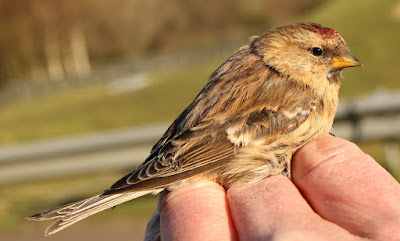“Don’t count the days. Make the days count” - a quote from the greatest boxer of all time Muhammad Ali.
On that basis I rose at the unearthly hour of 0530 on Friday to meet up with Andy out Pilling way to once again set up mist nets in the half-light of 3° where cold fingers fought to stay warm. With no time for chitchat our priority was to set nets in readiness for early birds in search of a worm or two, hopefully Redwings. As the morning progressed we expected to add more species and numbers.
Although we have both seen and caught numbers of Redwings this autumn, the strange weather of the last three weeks has seen very few Fieldfares to accompany their cousins. The two thrushes often arrive together in mixed flocks of tens, dozens, hundreds or even thousands, but not this year. Perhaps Friday would see both arrive as dawn broke or soon after?
There were no Fieldfares again so we made do with three Redwings that found the net in the dark. Those were the only ones we caught out of 40+ that flew over in tiny groups in three hours and more.
The morning continued with a light drizzle out of the 100% grey cloud and poor visibility, murk that hung around for quite a while and prevented us from any useful birding. The light was so poor that my camera stayed in the car, these pictures from previous days.
The most notable thing about Friday morning was how the highly mobile Linnets reached approximately 200/250 individuals, a number reflected in our catch of 21. This brings the total of Linnets ringed here this autumn/winter period to 192 - with zero recaptures. If only we could persuade more NW ringers to target Linnets we might together discover more about this Red Listed species.
New birds caught: 21 Linnet, 3 Redwing, 2 Greenfinch, 1 Wren, 1 Long-tailed Tit, 1 Blue Tit and 1 Reed Bunting.
Redwing
Linnet
Greenfinch
Reed Bunting
News arrived of a Lesser Redpoll, Ring number AKE3924, a second year female we ringed up at Oakenclough back on 19 March 2020.
AKE3924 was recaptured over the Pennine Hills by other ringers in Spennithorne, North Yorkshire on 20 October 2021, a duration of 586 days and a distance of 73 km.
This is another between years Lesser Redpoll recovery that tells us little except that both dates coincide with known migration times of Lesser Redpolls and also their north/south and south/north movements in spring/autumn.
Lesser Redpoll - Oakenclough, Lancashire - Spennithorne, Yorkshire
Lesser Redpoll
We live to ring another day but probably not this weekend when the weather again turns unfriendly.
The whole of next week looks reasonable in which to make our bird ringing and bird observations contribute to the wider picture. Log in then to Another Bird Blog to see how we do.





































